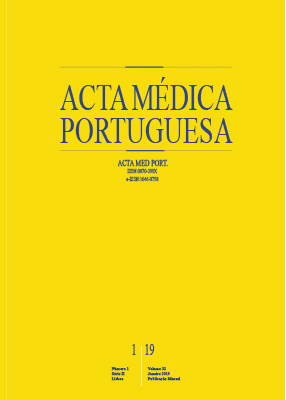The Impact of Prolonged Use of Continuous Subcutaneous Insulin Infusion in the Control of Type-1 Diabetes
DOI:
https://doi.org/10.20344/amp.10778Keywords:
Diabetes Mellitus, Type 1, Glycated Hemoglobin A, Infusions, Subcutaneous, Insulin Infusion Systems, InsulinAbstract
Introduction: The use of continuous subcutaneous insulin infusion therapy in type 1 diabetes mellitus has increased due to its benefits on glycemic control and on the lifestyle flexibility. The aim of this study was to assess the impact of continuous subcutaneous insulin infusion therapy on glycemic control, body mass index, total daily dose of insulin and complications associated with this therapy, during 20 years of experience in Centro Hospitalar e Universitário de Coimbra.
Material and Methods: This retrospective study included patients with type 1 diabetes mellitus who started continuous subcutaneous insulin infusion therapy up until 2005, followed at Centro Hospitalar e Universitário de Coimbra. Glycated hemoglobin A1c, body mass index, total daily dose of insulin and acute complications associated with continuous subcutaneous insulin infusion therapy were evaluated immediately prior to initiation of continuous subcutaneous insulin infusion therapy with follow-up at six months, one year, five, 10, 15 and 20 years. The frequency of acute complications associated with this type of therapy was also evaluated.
Results: This study included 20 patients (seven males, 13 females) with mean disease duration up to the start of continuous subcutaneous insulin infusion therapy of 16.1 ± 7.9 years, mean age of onset of continuous subcutaneous insulin infusion therapy of 31.1 ± 8.4 years and follow-up during 13.2 ± 2.3 years. The reasons for initiating pump therapy were: inadequate metabolic control in 15 patients, history of asymptomatic or severe hypoglycemia in four patients, and pregnancy/pregnancy planning in one patient. The previous median of glycated hemoglobin A1c was 9.3% (6.5 – 16.0) and, at six months, decreased to the minimum value of 7.2% (5.3 – 9.8); p < 0.0125. The reduction of glycated hemoglobin A1c remained statistically significant in the first 10 years of follow-up. There was a statistically significant difference in the body mass index variation at 10 years with continuous subcutaneous insulin infusion therapy compared to previous body mass index; 24.7 kg/m2 (18.9 – 31.8) vs 25,5 kg/m2 (18.9 – 38.9), p < 0.0125. Daily insulin requirements were reduced from 56.5 U (32.0 – 94.0) to 43.8 U (33.0 – 64.0) (p < 0.0125) at six months and no statistical differences were found in the remaining follow-up. There were two severe episodes of hypoglycemia (incidence 0.0095/patient/year), five episodes of diabetic ketoacidosis (0.0238/patient/year) and no infections at the site of catheter insertion.
Discussion: This study shows that continuous subcutaneous insulin infusion therapy improved glycemic control, especially during the first 10 years of follow-up and allowed a significant decrease in total daily dose of insulin in the first six months. The rate of acute complications was low.
Conclusion: Treatment with continuous subcutaneous insulin infusion therapy seems effective in achieving metabolic control in selected patients with type 1 diabetes mellitus.
Downloads
Downloads
Published
How to Cite
Issue
Section
License
All the articles published in the AMP are open access and comply with the requirements of funding agencies or academic institutions. The AMP is governed by the terms of the Creative Commons ‘Attribution – Non-Commercial Use - (CC-BY-NC)’ license, regarding the use by third parties.
It is the author’s responsibility to obtain approval for the reproduction of figures, tables, etc. from other publications.
Upon acceptance of an article for publication, the authors will be asked to complete the ICMJE “Copyright Liability and Copyright Sharing Statement “(http://www.actamedicaportuguesa.com/info/AMP-NormasPublicacao.pdf) and the “Declaration of Potential Conflicts of Interest” (http:// www.icmje.org/conflicts-of-interest). An e-mail will be sent to the corresponding author to acknowledge receipt of the manuscript.
After publication, the authors are authorised to make their articles available in repositories of their institutions of origin, as long as they always mention where they were published and according to the Creative Commons license.









